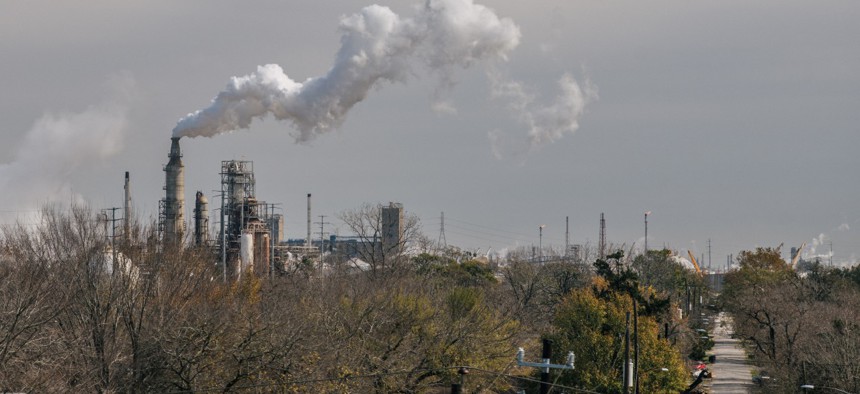White House’s Environmental Justice Tool Still Comes Up Short, Advocates Say

An oil refinery is seen past a residential neighborhood in Houston. Brandon Bell via Getty Images
Groups worry that the criteria that determines which communities qualify is too broad and may lead to federal grant money bypassing the people who need it most.
Environmental justice groups say a White House screening tool to help direct federal grant money to historically disadvantaged areas still misses the mark because it doesn’t identify the places where residents have been hardest hit by pollution and other environmental harms.
“There is a real concern within environmental justice communities that, in the absence of really specific guidance that target communities, this will be another once-in-a-lifetime opportunity where money just bypasses the people who most need it,” said Dana Johnson, the senior director of strategy and federal policy for WE ACT for Environmental Justice.
President Joe Biden set a goal of directing 40% of the benefits from federal investments in infrastructure, clean energy, and other climate-related programs to areas that are “marginalized, underserved and overburdened by pollution.” That initiative, called Justice40, could direct grants from dozens of federal agencies to historically neglected areas.
Environmental justice advocates have cheered the administration for introducing the initiative, the first of its kind at the federal level. But they worry that the criteria that determines which communities qualify might be too broad and lead to federal grant money bypassing those most in need.
Those concerns have grown after the White House made changes to the screening tool last year, which were intended to address criticisms that the first version of the tool left out too many distressed areas. Advocates complained that the initial release failed to include Appalachian areas with abandoned coal mines, vast stretches of Alaska or places with multiple environmental and health threats.
But the places that the White House added with updates were predominantly white and rural, and they do not face the types of cumulative danger found elsewhere, Johnson said.
“We know that race is the No. 1 indicator for pollution exposure and disinvestment in this country. There’s absolutely no way around that,” she said. “If there’s people who are being added to the tool who qualify for having resources directed to them who are not people of color, then the tool is simply rendered ineffective.”
A WE ACT analysis found that the percentage of white residents in neighborhoods identified by the White House screening tool increased by 4.5% after the revisions. The number of Hispanic residents decreased by 2.8% and Black residents decreased by 1.8%.
The White House decided not to use race as a factor in its screening protocols because they are worried that doing so would ensnare the program in legal battles. A judge blocked a previous Biden administration effort to forgive loans for Black farmers after a white farmer sued saying it violated his right to equal protection under the law, and the conservative bloc of the Supreme Court has repeatedly limited the instances in which public institutions can use race as an explicit factor for policy decisions.
“Race has a huge impact on environmental justice. And there’s just no way to look at environmental justice that pretends that race is not important,” said Bob Dean, the chief strategy and program officer for the Chicago-based nonprofit Center for Neighborhood Technology. Without using race as a factor, the administration needs to find ways that better account for the types of disinvestment and environmental hazards that people of color face, he said.
The current tool does identify many of those neighborhoods, Dean explained, but it does not prioritize them above other areas that qualify.
“One of our biggest concerns is that whether you have one degree of injustice or 20 degrees of injustice, you’re treated the same,” he said.
The White House’s approach differs from how other federal agencies and state governments have identified eligible neighborhoods. A new tool from the federal Transportation Department, for example, uses data from six different factors to determine eligibility: transportation access, health, environment, economy, resilience and equity.
Other federal agencies developed separate tools, including the Department of Energy, the Centers for Disease Control and Prevention, and the Federal Emergency Management Agency. On top of that, 30 states and localities have developed similar screening tools, according to the Environmental Policy Innovation Center.
The different standards pose problems for local agencies that want to apply for federal grants, said Dean, especially if their state’s screening tool produces different targeted communities than a federal agency’s. He said the White House could have built a more robust tool by working more closely with environmental justice advocates and state agencies that have worked on similar issues for a decade or more.
The White House issued a memo in January urging federal agencies to use its Climate and Economic Justice Screening Tool as the “primary tool used by agencies for … geographic identification of disadvantaged communities” in the future.
Still, the Transportation Department last month requested public comments on how it could improve its own screening tool.
The White House did not respond to a request for comment.
NEXT STORY: White House pitches $1.6B in anti-fraud funding






